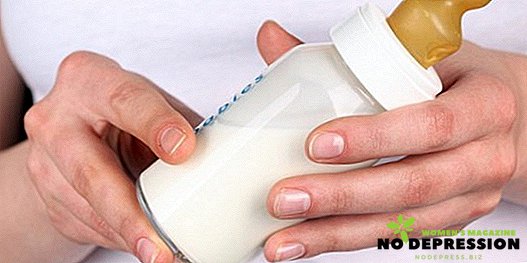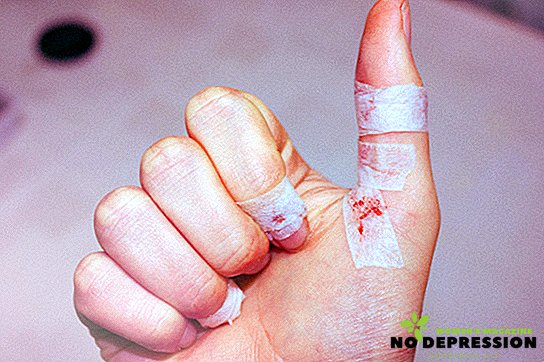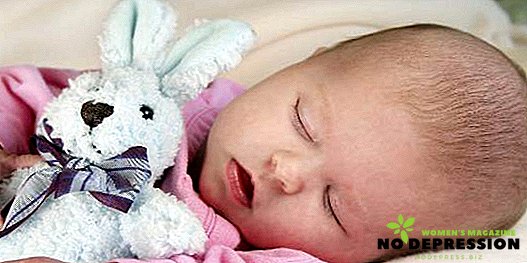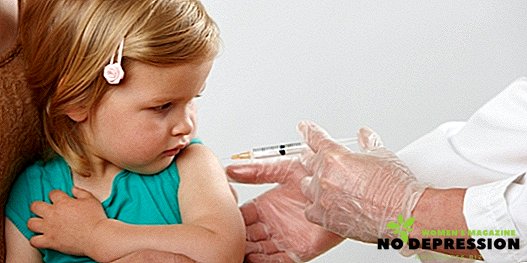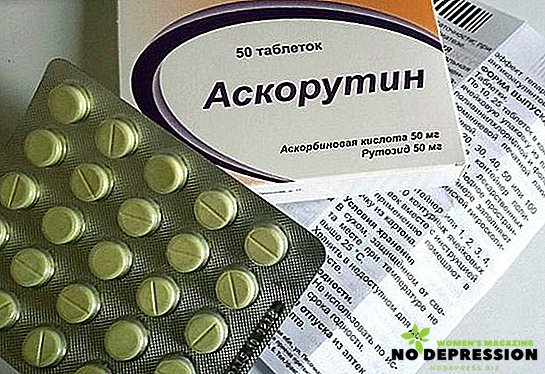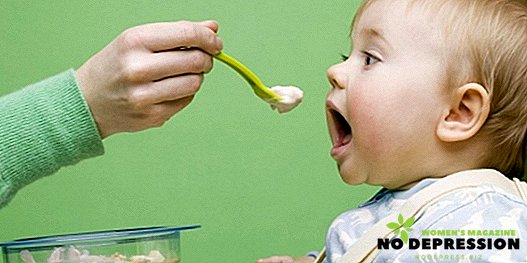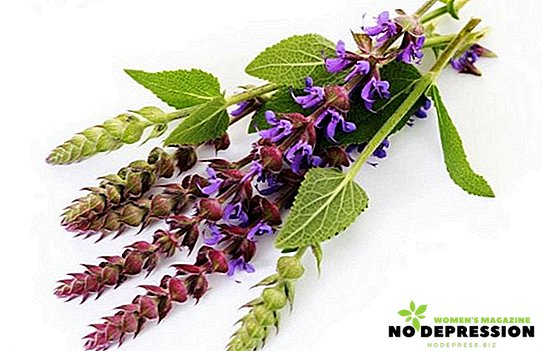Bronchitis is a respiratory disease that has serious complications. Parents have a lot of questions about the treatment of this pathology: when to take antibiotics, can the child be cured with inhalations, warming procedures. However, it is worth remembering that a lot depends on the type of bronchitis and the reasons for its occurrence. Therefore, any home treatment methods must be agreed with the doctor.
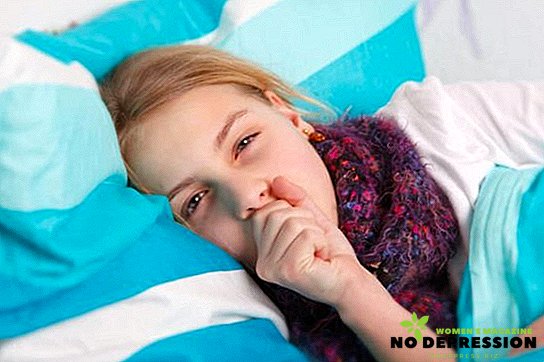
What is bronchitis?
Bronchitis - inflammation of the bronchial mucosa. The disease may be infectious or allergic nature. Often, inflammatory processes appear on the background of influenza or ARVI.
Most often, infectious bronchitis affects children in the cold season, with a weakened immune defense. The infection enters the body from the outside by inhalation of contaminated air. It is also possible to activate its own pathogenic microflora, which also contributes to reduced immunity and hypothermia of the body.
Depending on the cause of appearance, there are types of bronchitis such as:
- Bacterial. The causative agents are bacteria, such as staphylococcus, pertussis, mycoplasma, streptococcus.
- Viral. Appears when the virus enters the body of influenza or adenoviruses.
- Allergic. Occurs in case of irritation of the bronchi with chemicals, dust, etc.
The infectious type of bronchitis is contagious - if the patient sneezes or coughs, the virus can spread around him 10 m.
When breastfeeding the child already has passive immunity - with mother's milk, he receives protective antibodies to various infections. Therefore, children under one year of age suffer from bronchitis only if there are deviations in the development of the respiratory organs, if the body is weakened by other pathologies.
The development of infection in the bronchi occurs when the mucus that forms in them during irritation or inflammation dries out and blocks the respiratory passages. In this case, the ventilation of these organs is disturbed.
Causes of the disease
The causes of bronchitis in children are:
 penetration of viruses, bacteria from the air, upon contact with a sick person;
penetration of viruses, bacteria from the air, upon contact with a sick person;- infection of the respiratory tract while licking toys and other objects;
- infection with parasites, infection through the blood;
- congenital pathologies of the respiratory system, which lead to stagnation of sputum, chronic inflammatory processes;
- staying in a smoke-filled room, inhaling gasoline vapors or chemicals;
- contact with respiratory tract irritating particles or contact with a substance that has a strong odor.
If the treatment of bronchitis was carried out at the wrong time or was ineffective, this disease can turn from acute to chronic. In this case, it will last for years with periodic relapses. Most often, recurrent bronchitis occurs in children aged 4-7 years. The disease can be repeated up to 4 times a year after a cold for 1.5-2 years in a row. There are no attacks of bronchospasm. The probability of complications increases in case of inflammation of the adenoids or in the presence of chronic tonsillitis.
Factors that contribute to the appearance of bronchitis in an infant are:
- early weaning;
- smoker in the house;
- inappropriate sanitary conditions for living.
What is the danger of bronchitis?
Since the airway is markedly reduced with this disease, this pathology is dangerous due to the lack of ventilation in the child. Less oxygen gets to the lungs, so less gets into the blood. As a result, temporarily all organs and tissues receive less oxygen that is vital for their work. In addition, it is bronchitis - a common cause of pneumonia.
This happens approximately as follows:
- Because of the temporary obstruction of the bronchi, the lungs are poorly ventilated, but at the same time bacteria and viruses penetrate there anyway.
- Having settled inside the lungs, which are deprived of ventilation, microorganisms begin to multiply as quickly as possible.
- The inflammatory process that is caused by this activity is pneumonia.
Alas, in children it is pneumonia is the most common complication, especially with the wrong treatment. And in itself bronchitis is a serious disease, the cure of which, even for adults, is sometimes difficult. Children also suffer even more, because sputum clots accumulate deep in the bronchi, and kids are unable to get rid of them.
And all because removing the mucus from the respiratory tract is possible only with the help of the respiratory muscles - it is very poorly developed in children under 7 years of age. Simply put, children cough a year, but can effectively cough up only when the muscles get stronger. This may explain the fact that most respiratory diseases occur in children much more difficult than in adults.
Symptoms of bronchitis of various types
 The respiratory system in children has its own characteristics. The respiratory passages are narrower, due to which it is possible to quickly overlap them with the appearance of edema. Congenital defects of the lungs or bronchi appear most often in infants, but after one and a half years the abnormalities most often disappear.
The respiratory system in children has its own characteristics. The respiratory passages are narrower, due to which it is possible to quickly overlap them with the appearance of edema. Congenital defects of the lungs or bronchi appear most often in infants, but after one and a half years the abnormalities most often disappear.
Immunity in children is still in the developmental stage, susceptibility to infections is increased. The respiratory muscles are also weaker, due to which ventilation is worse than in adults.
In addition, the volume of the lungs in children is smaller, it contributes to the rapid spread of infection. Also, children have insufficiently developed thermoregulation of the body - they overheat much more quickly and catch cold.
Types of bronchitis
The following types of acute illness exist:
- Plain. Manifested in a mild form, may occur without symptoms.
- Obstructive. Severe dangerous condition in which respiratory failure may occur.
- Bronchiolitis. There is inflammation of the bronchioles, which can lead to blockage of the pulmonary vessels and the appearance of heart disease.
Bronchitis of any type begins with simple signs of a cold, after which they become chronic and resemble inflammation.
Symptoms of simple bronchitis
Against the background of a cold in a child can be observed:
- general weakness;
- headache;
- strong dry cough up to a week;
- drying of the mucous membranes can lead to sipotis in the bronchi;
- if the inflammation affects the larynx, a barking cough may form;
- the temperature rises to + 37 ... +38 degrees depending on the severity of the pathology.
Gradually, dry cough becomes wet, gurgling rales may appear. If sputum discharge occurs normally, the patient's condition improves significantly. The disease in this form can last up to three weeks. Also, the symptoms depend on the age of the child, general health, physical development.
 If you start the disease, you may receive complications such as bronchiolitis or pneumonia. In some cases, a disease that occurs in a viral form, is not very familiar. After the death of the virus, the child immediately becomes better, but then the condition worsens again, the temperature may rise, the cough increases, headache appears.
If you start the disease, you may receive complications such as bronchiolitis or pneumonia. In some cases, a disease that occurs in a viral form, is not very familiar. After the death of the virus, the child immediately becomes better, but then the condition worsens again, the temperature may rise, the cough increases, headache appears.
This indicates that a bacterial infection has joined the viral infection, which requires urgent treatment with antibiotics. The infection process can be unilateral and bilateral. One of the signs of the disease is redness of the eyes as a result of inflammation of the mucous membrane.
Symptoms of obstructive bronchitis
The symptoms of this type of bronchitis are most often manifested in children under 4 years of age. Most often occur in the presence of viral or allergic forms of pathology. Key features:
- noisy and hoarse breathing;
- paroxysmal cough;
- swelling of the chest.
With this form of the disease, the temperature does not rise. In this case, obstructive bronchitis can occur suddenly after playing with pets or if the child is inhaled with chemical odors, such as paint during repairs.
Symptoms of obstruction usually appear 4 days after the flu or ARVI. Seizures of dry cough, which does not bring relief, are characteristic of him, wheezing can be heard in the lungs. Till 4 years relapses are possible, after which the attacks most often stop.
Signs of bronchiolitis
The main symptom is shortness of breath. In the beginning, it can appear in a child if he was moving actively, but eventually manifests itself in a state of rest. During inhalation, you can often hear hissing. When listening, the specialist will hear wheezing at the bottom of the bronchi. As a rule, with this form of bronchitis, the temperature can rise to +39 degrees.
The child is difficult to exhale. The chest and shoulders are raised. The face may be swollen, turn blue. Continuing cough with a small sputum does not give any relief, but only causes pain. The manifestations of this form of bronchitis also include dry mouth, problems with urination, rapid heartbeat.
How does bronchitis in children of different ages?
Bronchitis after a cold - a frequent phenomenon. However, it often happens easily: the temperature does not rise, the cough is insignificant.
In complicated cases, the temperature can be very high, bronchial spasms and choking can occur. The disease begins with the usual dry cough, over time in the bronchi accumulates sputum, which can become mucopurulent. There may be wheezing, they can be considered a sign of the transition of the disease to the stage of recovery.
During this period, it is important to facilitate the excretion of sputum, clear the bronchi from infections. The child is not always able to cough up and spit out sputum himself. There can not do without the help of parents - the baby needs to turn on its side.
At the same time, sputum moves along the walls of the bronchi, which leads to their destruction and the appearance of cough. In infants because of the difficulties with the discharge of mucus from the bronchi, often the main symptom of this disease are bouts of severe cough with shortness of breath. At the age of 2 months to six months, bronchitis usually occurs in the form of bronchiolitis. With a simple form of bronchitis, recovery occurs after about 7 days. If it is complicated by obstruction, it can manifest itself within 2-3 weeks and even go into pneumonia.
Diagnostics
By the nature of the cough and the type of discharge of sputum, a specialist can determine what type of bronchitis has arisen in a child. For example, white sputum is more characteristic of viral inflammation, in the presence of a greenish-yellow hue, we can talk about bacterial inflammation of the bronchi. If bronchitis is allergic, then the child is coughing up lumps of clear mucus.
When examining and listening to the chest, the doctor will determine the presence of symptoms of bronchitis in children, such as:
- swelling of the chest;
- hoarse breathing;
- difficulty breathing out.

By taking a general blood test, you can determine the number of leukocytes, which increase in the presence of an inflammatory process. When dangerous complications need to do an x-ray of the lungs. At the same time, equipment with a reduced dose of radioactive radiation is used to examine children. Also pneumotachometry is carried out: thanks to special devices, the doctor examines the airway patency during inhalation and exhalation.
If there are signs of an infectious pathology, it is necessary to do a sputum test to determine the type of pathogen. To diagnose bronchiolitis in infants, a histological examination of sputum is carried out. An important sign of inflammation of the bronchi is cyanosis, that is, cyanosis of the skin and mucous membranes, which may occur due to cardiac or pulmonary insufficiency.
Also for the diagnosis of the presence of wheezing and shortness of breath, the frequency and strength of the heartbeat. A strong cough often occurs in other diseases, such as pneumonia, tuberculosis. Also, its causes can be congenital pathologies of the respiratory system, the ingress of a foreign body. With the help of a properly performed diagnosis, you can confirm the presence of bronchitis and prescribe proper treatment.
Features of treatment
First of all, you need to remember that in no case can self-medicate with such a pathology. According to the pediatrician Komarovsky, a child with bronchitis can be injured both by the uncontrolled intake of medicines and the improper use of home treatment methods.
At home, in the treatment of simple bronchitis, the child is shown bed rest at high temperature. As soon as it is normalized, it is necessary to bring the child to the fresh air.
It is often necessary to give him warm tea, compotes, while the fluid intake should be increased at least 1.5 times compared to normal. This will help to thin the sputum, quickly withdraw it from the bronchi. An infant should be applied to the breast as often as possible, additionally including water in his diet.
Thermal procedures, such as mustard plasters, chest rubbing, can be performed only in the absence of elevated body temperature.
Drug treatment
Most often with bronchitis prescribed drugs listed below.
Antiviral drugs
For example, Arbidol, Anferon, Interferon for acute bronchitis. The doctor will prescribe medication and dosage based on the age of the child, his weight.

Antibiotics
With this pathology, they are effective only if the disease is bacterial in nature. They are prescribed if thick sputum has a yellow-green color, there is a high temperature, breathing is difficult, there are symptoms of intoxication of the body, such as nausea, sleep disturbances, headaches. The presence of a bacterial infection can be said if the symptoms of the disease do not disappear within 10 days after the start of antiviral treatment.
Also, antibiotics are prescribed, if the child has bronchodilator and there is a risk of its transition to pneumonia. Most often, children are prescribed Azithromycin, Supraks and Sumamed.

Cough drops
The most commonly used drugs of the following types:
- Expectorant, such as Pertussin, a decoction of some herbs.
- Means for liquefying sputum, such as Bromhexin or Lasolvan. In this case, children under two years old should not be given expectorant drugs, since their use will only increase coughing attacks. If the liquefied sputum gets into the airways and lungs, it will lead to even more serious complications.
Antipyretic drugs
Used with high temperature. Children are most often prescribed Panadol, Nurofen, Ibuklin.

Antihistamines
Used in the treatment of allergic bronchitis. For the treatment of children older than six months, Zyrtec is used, Erius can be used from 1 year, Claritin - from 2 years.
Inhalants
They are usually used in the presence of obstructive acute bronchitis. The procedure is performed using a special inhaler. The most commonly prescribed drugs such as Salbutamol and Atrovent.

Traditional methods of treatment
Traditional medicines based on natural ingredients will help alleviate the condition of the child, conduct preventive treatment to prevent relapse and strengthen the immune system. Such drugs can be taken only after consultation with the doctor.
As an expectorant, you can use
- mother-and-stepmother's decoction, which soothes a cough;
- decoction of Hypericum, which has a bactericidal and anti-inflammatory effect;
- A well-known cough medicine for bronchitis is baked radish with honey or oatmeal broth.
To effective home methods also include procedures that warm, for example, foot baths, cans, mustard plaster. An important measure for the prevention of bronchitis - timely treatment of colds, rhinitis, and infectious diseases of the throat. Also, the child is recommended to temper, to teach physical education, a lot of time to spend with him in the fresh air.


 penetration of viruses, bacteria from the air, upon contact with a sick person;
penetration of viruses, bacteria from the air, upon contact with a sick person;